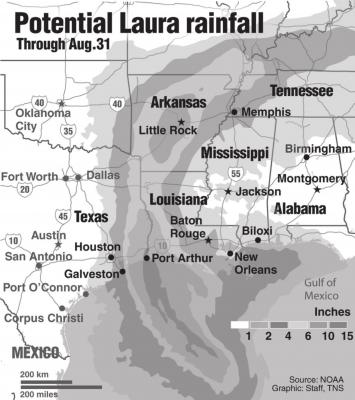Laura set to be ‘potentially catastrophic’ Category 4 hurricane
Hurricane Laura is poised to become a Category 4 storm that could wreak catastrophic damage in Texas and Louisiana, bringing a life-threatening storm surge, flash flooding and destructive winds that could leave areas uninhabitable for weeks or months.
Laura’s winds are forecast to peak at 130 miles per hour over the Gulf of Mexico, but may weaken slightly before hitting the coast on Thursday, according to the National Hurricane Center. The jump in power means the storm could cause $20 billion to $25 billion in damage and economic losses, Chuck Watson, a disaster modeler with Enki Research, said on his blog.
For anyone living in an area that floods or is in the direct path of Laura’s landfall, “there is not calculation to be made: Get out,” Watson said. “Whatever fears you might have about COVID are secondary -- even those with heath issues that might make riding out a weaker storm an option.”
Though strong hurricanes often lose power just before landfall, Laura’s forward speed might prevent that from happening, allowing it to come ashore as a Category 4 storm, said Don Keeney, a meteorologist with commercial forecaster Maxar.
The storm is targeting the heart of America’s energy industry. It’s already shut more than 80% of oil production in the Gulf of Mexico and a third of the Gulf Coast’s refining capacity, halted exports and prompted mandatory evacuations. It’s set to be the first major system to hit the Gulf Coast since Michael in 2018.
“Laura has become a formidable hurricane,” the NHC said on its website. A “life-threatening storm surge with large and dangerous waves is expected to produce potentially catastrophic damage from San Luis Pass, Texas, to the mouth of the Mississippi River.”
After Laura rips across the Gulf Coast, it will leave a path of destruction through the Mississippi Valley before turning on the Mid-Atlantic region that just recovered from Hurricane Isaias, said Jim Rouiller, lead meteorologist with the Energy Weather Group. There is a possibility Laura will re-intensify once it makes it to Maryland, New Jersey and possibly New York, he said.
The tropical threat has prompted more than 84% of oil output and nearly 61% of natural gas production in the Gulf of Mexico to be shut, according to the Interior Department’s Bureau of Safety and Environmental Enforcement.
Gulf Coast refineries and petrochemical plants are often located in low-lying areas vulnerable to flooding. In 2017, an Arkema SA chemical plant about 25 miles east of Houston had a fire and explosion after it was flooded by Hurricane Harvey. Last September, Exxon shut its Beaumont refinery in Texas because of flooding from Tropical Storm Imelda.
Laura could push sea levels as high as 15 feet in the Sabine Pass area and along parts of the Texas coast where the Henry Hub is located, the hurricane center said at 5 a.m. New York time. Storm surges kill almost half of all people who die in hurricanes.
The last hurricane to hit Texas as a Category 4 storm was Harvey in 2017, which came ashore and then got pinned in place by larger weather patterns, causing it to send record rains across the eastern half of the state for days. The last hurricane to hit Texas was Hanna in July.
Some of the largest U.S. refineries are winding down in advance of Laura, shutting in nearly 2.9 million barrels a day of capacity. That’s about 30% of U.S. Gulf Coast refining capacity, according to Lipow Oil Associates.
Energy platforms in the Gulf of Mexico that account for as much as 17% of America’s oil production and about 3% of gas output are designed to withstand storms of this magnitude.
President Donald Trump has ordered the Strategic Petroleum Reserve to be made available in case of storm-related fuel disruptions, U.S. Energy Secretary Dan Brouillette said in an interview with Bloomberg TV.
Many areas along the coast, including Port Arthur and Jefferson County, Texas, have ordered residents to evacuate.
Laura will be a record seventh system to hit the U.S. by August, and more are coming, Rouiller said.
Cheniere Energy Inc. said it was temporarily suspending operations at its Sabine Pass liquefied natural gas terminal in Louisiana, the nation’s largest. Sempra Energy’s Cameron LNG in Louisiana will operate at reduced rates.
Western sugarcane in Louisiana between Lake Charles and Lafayette will be the most at risk, said Drew Lerner, president of World Weather Inc. in Overland Park, Kansas. For cotton crops, some parts of the western Mississippi Delta area, and central and interior parts of Arkansas also could be impacted, he said.
The governors of Texas, Louisiana and Mississippi have all declared emergencies. Laura killed at least nine people in Haiti and the Dominican Republic, the Associated Press reported.

